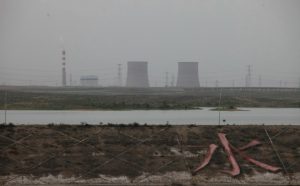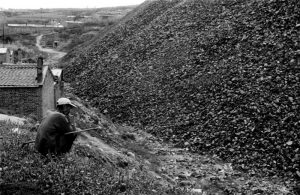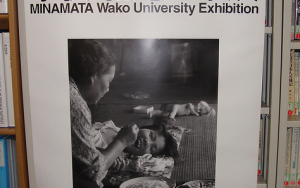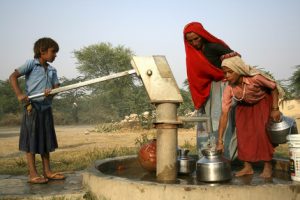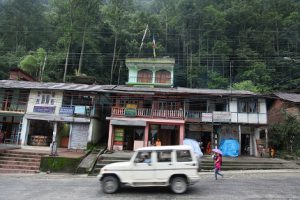Saleem Ali is director of the Centre for Social Responsibility in Mining at the University of Queensland, Australia, and part of a research project promoting cleaner gold-mining in western China. The team has been testing out a new technique to extract fine gold from ore without mercury or cyanide at the Axi gold mine in Xinjiang province, in Western China.
Olivia Boyd (OB): What are the environmental challenges around gold mining?
Saleem Ali (SA): The main issue environmentalists bring up is that this is a metal which is largely mined for luxury products – the majority of the mining is done for jewellery. However, if you think of gold mining as a livelihood-generation mechanism, then you have a slightly different perspective on it. For the miners it’s a very important source of livelihood, and it may happen in areas where there are not many other opportunities.
Also, there are different tiers of livelihood and that’s where the work in Xinjiang becomes important. There, you have large-scale mining but you also have the artisanal mining and the small to medium scale mining. Gold is often the metal of choice for that. That’s partly because it’s fairly ubiquitous – in terms of its dispersion in the earth’s crust, gold is found in lots of places. It’s just that the amount is small. That’s why you can find gold-panning happening in so many different parts of the world at the small-scale level.
The environmental challenge of course is that, because gold is so diffuse, in order to harness it you generate a lot of waste. And the most costly waste at the small scale is mercury or cyanide, which are used to separate the gold from the ore. Both of those are very prominent from a pollutant perspective.
OB: What are their impacts?
SA: If you use mercury, you amalgamate the gold with the mercury and then burn it off, and so the mercury will deposit itself somewhere within the ecosystem. Mercury is what we call biopersistent – it gets eaten up by organisms and then stays in the environment for a very long time. And it’s a neurotoxin, so you don’t see the impact right away. It actually has a much more insidious impact over many years. Mercury pollution across China is widely documented.
With cyanide, it’s different. Cyanide has an immediate impact, but it’s not biopersistent. Cyanide can actually decompose in sunlight. So you can get a sudden fish kill from a cyanide spill but it doesn’t have the long-term persistent impact that mercury might have.
OB: What happens to the waste at the moment?
SA: The large-scale mines usually make tailing dams – they store the tailings behind impoundments. And that’s where they are stored until they are stable enough to get dewatered, and then they may be re-vegetated down the road. But of course you have to be very vigilant about what you grow there – if there is heavy metal contamination, you can’t really eat food off of it. In other cases, depending on what remediation strategies you use you could actually have fully functional systems after the land has been remediated.
In Xinjiang, the project we’ve been doing is looking at the larger mines and seeing how a particular technology called CleanGold can help with improvement of yields for people who come and try to harness gold from the tailings – from the waste that’s already been generated.
So that’s the situation right now – you have a number of these larger, older mines and then you have people who go and try to harness gold from the tailings. What we’ve been trying to do is find a way by which, if they do that, at least they can do it in a way that’s not pollution intensive.
OB: What’s the solution?
SA: We’ve been looking at a technology which uses magnetism to get the gold out of these tailings. It can be used at the tailings level, which is what we were experimenting with, or it can be used generally by artisanal miners doing alluvial mining. It’s a clean technology since it doesn’t require any chemical usage.
It’s a process which was developed by David Plath, a former US government scientist. This particular material that he developed is a very finely granulated magnetic material, which is able to absorb the gold in a particular way. It’s basically a sluicing system, similar to what you might do with other types of artisanal mining, but instead of using mercury you add this magnetic material to the soil or the alluvial material you are using to extract the gold from.
There have been questions about how much yield you get. So what we were doing through this National Geographic project was to show that you can actually get a fairly decent yield off the gold using this particular technique, which is mercury free and cyanide free. The fact that the technique was able to recover gold particles as fine as 1250-mesh – 12 microns – from mine tailings which would have otherwise been discarded reflects the method’s efficacy.
OB: What sort of response did you get?
SA: There’s been positive response from these mining companies. There’s a Gold Mining Council of Xinjiang, and they were quite receptive, they want to upscale it and see how it can be developed further with the Xinjiang Institute of Geography and Ecology, where we did this project. So there is definitely interest in moving further. And we’re looking into a phase two of the project where we can see how this process which we demonstrated at the micro level can be taken up a step so they might be able to harness more gold through this process.
The other part of this is that it’s actually a very labour intensive process, which actually provides livelihoods for people. In a developing country context, sometimes you don’t necessarily want mechanisation and high levels of productivity – you actually want people to be able to be employed. In South Africa too they’re resisting automation because they want people to be employed, and the companies have been willing to do that with platinum mines here, which are very labour intensive.
OB: What levels of environmental awareness did you encounter?
SA: I think China’s trying to demonstrate that it’s willing to embrace innovation. They’ve had enormous pollution challenges and so they’re trying to highlight how they can actually address these kinds of issues through smart and efficient technologies. In the last year especially, whether it’s air pollution or water pollution, China has had a significant amount of negative publicity about those matters. I think there’s much more willingness to engage – I’ve been working in China for 15 years on various kinds of research partnerships and in the last couple of years there’s just been much greater willingness from both the private sector and the government to explore new ideas.
And then there’s the fact that China has signed on to the Minimata Convention on mercury reduction. This is something they can use to demonstrate they are actually committed to this kind of reduction mechanism.
OB: When Minimata was signed there was a lot of commentary about the scale of the challenge for China particularly. What’s your take on this?
SA: I think China has demonstrated that if it commits itself to particular mitigation mechanisms, it can do it with great alacrity. We’ve seen that clearly with the way in which they’ve demonstrated some of the transformation efforts in terms of urban planning. So I do feel they can meet the commitment. It would require much greater prioritisation of the issue within government ministries and so on.
Part of it is about the supply of mercury to the goldminers. I think you can deal with the demand side by providing alternative technologies, but if you have a very cheap supply of mercury available on the market, the miners are going to be tempted to use it. Because the use of mercury has diminished in other areas, there are huge stockpiles of mercury worldwide which get illegally sent around the remotest parts of the world. I’ve travelled in remote parts of Africa and you’ll see a mercury seller going around selling little globs of mercury for gold mining. So the supply side will have to be tackled also by the Chinese government to make sure it gets more restricted in terms of its availability.
That’s about better monitoring of where the mercury is coming from. There’s still some mercury mining going on at a small scale in some parts of China, so it’s possible on the one hand to go to the mercury mining source and make sure it’s better regulated. But there’s also a lot of mercury coming through other channels, from abroad and so on, and so I think it’s about understanding that whole supply chain. We don’t even fully know where it comes from in many cases, especially when it’s coming from secondary sources. That could be very important.
OB: What are the key barriers to the take up of solutions in western China?
SA: There isn’t a very concerted strategy around pollution management at the mining level. With air pollution, there is a much clearer, more concerted strategy now. With mining they’re beginning to get to it – for example the government has made a particular point around rare earths mining – but with a lot of the gold mining and the coal mining especially there hasn’t been a very concerted effort to go to the very far reaches of the country to manage these operations. I think that will require much more capacity building at local government level for enforcement.
Also, because of the sensitivity in Xinjiang itself, as an autonomous region, there’s going to be some level of devolution of authority. So keeping the balance between the federal government coming in to do the enforcement versus what is done by the regional government, that needs to be better applied. And actually environmental issues I would argue would be a very nice way for the federal government to say this is something beyond politics, it’s something that’s important all across the board for citizenry.
